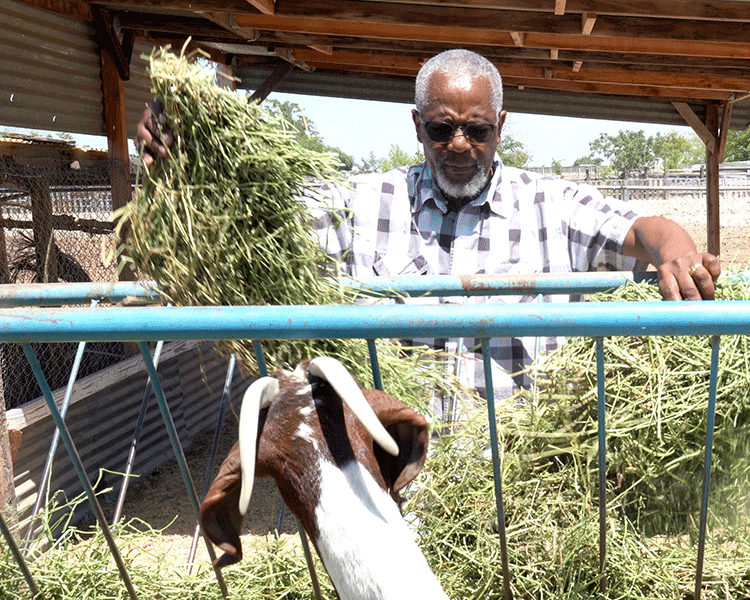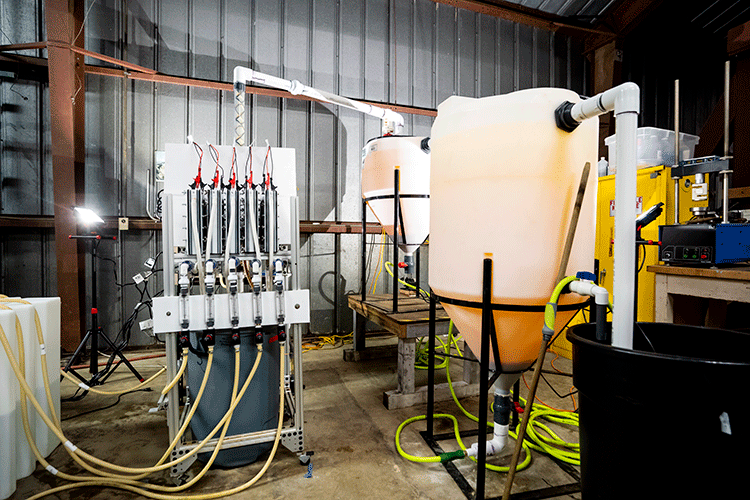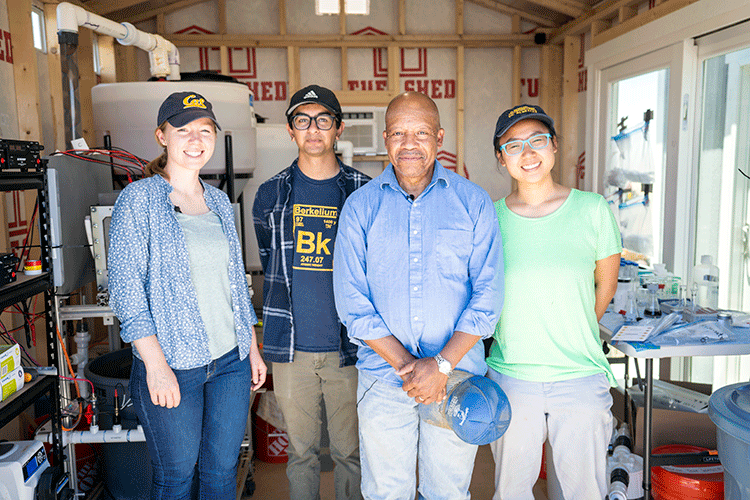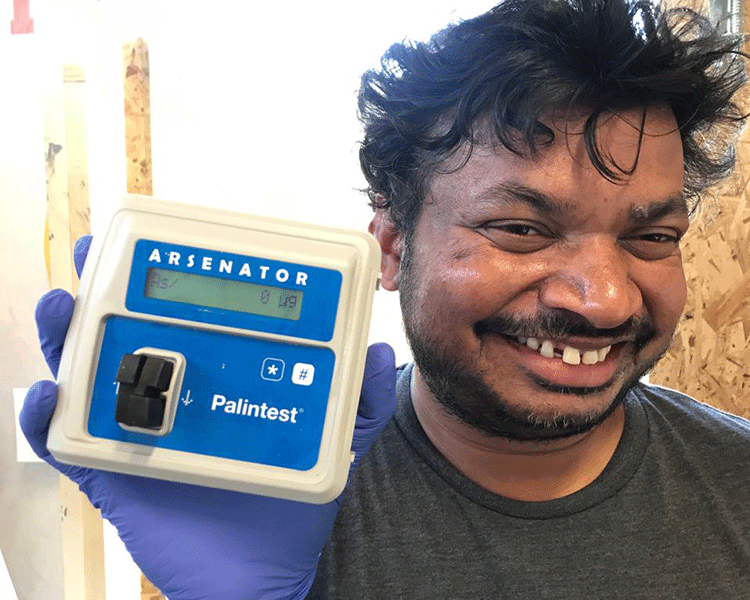Bringing arsenic-safe drinking water to rural California
UC Berkeley engineers have created a simple and low-cost new arsenic treatment system to help low-income communities access safer water
September 21, 2022
According to the Rev. Dennis Hutson, people used to love the taste of Allensworth’s water.
“People used to say things like, ‘Wow, this is the best water I’ve ever tasted!’” said Hutson, who owns a farm in the small Central Valley community. “There were even visitors who took gallon jugs of water home with them because they thought it tasted so good.”
Now, many residents of this historically Black community know that it is not safe to drink water from the wells in their town.
Like many areas throughout California, the groundwater beneath Allensworth is tainted with dangerous levels of arsenic, a highly carcinogenic element that can seep into the water table from deposits in the soil and bedrock. While cities and larger municipalities can afford to remove arsenic from their water, many people living in small and rural communities are forced to choose between drinking contaminated tap water or purchasing bottled water — and those with private wells may not even know that their water is unsafe.
In collaboration with Hutson and other Allensworth community leaders, engineers at the University of California, Berkeley, are currently field testing a simple and low-cost new arsenic treatment system that is designed to help small, rural communities like Allensworth access arsenic-safe drinking water.
Since early June, the system — housed within a small grey shed on Hutson’s farm — has been drawing groundwater from Hutson’s agricultural well and reducing its arsenic levels from an extremely toxic 250 parts per billion (ppb) to well below the Environmental Protection Agency’s (EPA) limit of 10 ppb. If the field test continues to be successful, the team hopes to obtain the funding to launch a pilot plant in the Central Valley.

A new Berkeley News series will examine how the campus community is confronting the climate crisis.
“An estimated 300,000 people in California are exposed to arsenic concentrations higher than 10 ppb in their drinking water,” said research team leader Ashok Gadgil, professor of civil and environmental engineering at UC Berkeley and senior faculty scientist at Lawrence Berkeley National Laboratory. “For the first time, we’ll be treating groundwater with high levels of arsenic at a price local people can afford and in a way that they can operate.”
As drought and extreme heat from climate change limit California’s supply of surface water, more and more municipalities will be relying on groundwater sources that may be contaminated with arsenic — and depletion of these upper groundwater aquifers might require reaching into older, deeper aquifers that might be more contaminated. An affordable arsenic treatment system could provide safe and sustainable sources of water for rural communities, while limiting the greenhouse gas emissions involved in bottling and transporting water from other locations.
“A lot of communities where the groundwater is high in arsenic have to resort to other solutions, like taking water from a nearby town … and not even viewing local water as an option for drinking water,” said Logan Smesrud, a senior research and development engineer in Gadgil’s lab. “This project is reframing what we can use for drinking water.”
For Hutson, creating a safe and reliable drinking source of drinking water will be key to helping Allensworth — the first town in California to be established by African Americans — grow into a self-sufficient and flourishing community.
“I want to see Allensworth thrive as an agricultural community focusing on sustainable, regenerative, organic agriculture,” Hutson said. “We need drinking water to not only survive, but thrive.”

Jay Majmudar, a research and development engineer in Ashok Gadgil’s lab at UC Berkeley, collects a water sample while the Rev. Dennis Hutson observes. (UC Berkeley photo by Adam Lau)
Building a future for a historic town
Sun-baked Allensworth is located about 45 miles north of Bakersfield on the ancestral lands of the Yokuts. The community was first founded in 1908 by Col. Allen Allensworth, an African American who escaped slavery to become a chaplain and the highest-ranking Black officer in the U.S. Army.
“Colonel Allensworth and a group of people came and founded this community of Allensworth … with the premise of being self-governed,” Hutson said. “They wanted safety. They wanted to be self-sufficient. And this town thrived as a result.”
During the 1910s, the community grew to a bustling town of more than 200 people, with its own school district, voting precinct and a variety of small businesses. But as the century wore on, a series of economic setbacks — including a lack of sufficient irrigation water — led to its slow decline. By mid-century, the population had dwindled to nearly zero.
Since the 1970s, community leaders have fought to keep the legacy of Allensworth alive, and the population has slowly rebounded. Allensworth is now home to about 600 people, the majority of whom identify as Latinx and are employed as farmworkers.
Hutson and his brother-in-law Kayode Kadara are both members of the Allensworth Progressive Association (APA), an organization dedicated to improving the quality of life for residents of the community. Kadara said that the APA is working to improve the town’s water infrastructure and sewer system, build additional housing and increase the availability of healthy food. But access to safe drinking water remains a central challenge.

Kayode Kadara feeds goats on Hutson’s farm. (UC Berkeley photo by Adam Lau)
“Almost any place you go in the region here, if they rely on groundwater for domestic use, arsenic is one of the major contaminants,” Kadara said. “In our case here, that’s our primary contaminant.”
To bring Allensworth’s tap water into compliance with the EPA’s limits on arsenic contamination, Kadara said that the community services district draws water from two wells located three miles east of the city, where arsenic levels are much closer to 10 ppb. By blending water from these two sources, the district can usually bring the arsenic levels below to the EPA limit — but exceedances still occur. Because the wells are located near grazing land, the water also occasionally becomes contaminated with bacteria, and residents are required to boil their tap water before drinking it.
As a result, many residents choose to drink bottled water or drive to neighboring towns to fill up jugs at water kiosks. This places an extra financial burden on families who are already struggling to make ends meet.
“There are people who will have a five-gallon jug, and they will go to Delano, which is 15 miles away from here, to buy water,” Hutson said.
The APA was first introduced to Gadgil by Tom Tomich, a Distinguished Professor of Sustainability Science and Policy at the University of California, Davis, who visited Allensworth with a group of other educators and philanthropists in 2017.
“My brother-in-law, Kayode Kadara [said], ‘There is one thing you can do for us — do you know anyone who can get arsenic out of the water?’” Hutson said. “[Dr. Tomich] contacted us about a month, month and a half later, and Dr. Gadgil was on the phone, and we talked and persuaded him to come to Allensworth and employ his technology. We’ve had a wonderful relationship ever since.”

Gadgil’s team built and tested the arsenic treatment system at UC Berkeley’s Richmond Field Station before transporting it to Allensworth in the spring of 2022. (UC Berkeley photo by Adam Lau)
From India to California
For more than 15 years, Gadgil and his team have been developing low-cost arsenic treatment systems to provide safe water for rural communities. Since 2016, their first treatment plant, at a high school outside of Kolkata, India, has provided affordable, safe drinking water to 3,000 students and members of the local community. The plant was built with grant funding from the Indo-U.S. Science and Technology Forum, and in collaboration with Jadavpur University and an Indian industrial licensee of Gadgil’s technology. The industrial licensee has built and is now operating a second treatment plant in India.
“The [technology] that we designed for India, near Bangladesh, is highly effective, but slow, low-cost and relatively labor-intensive; it is well suited for the Indian rural poor,” Gadgil said. “There, the arsenic concentration in the groundwater is 250 parts per billion, and we bring it down to 3 parts [per billion], and still they can afford it because it costs them 0.8 cents per liter and also provides local employment.”
While eastern India and Bangladesh have some of the highest levels of arsenic groundwater contamination in the world, additional hot spots appear around the globe, including in the U.S. Here, larger municipalities can use a process called reverse osmosis to remove arsenic and other contaminants from groundwater. However, this process requires both a costly facility and trained staff to run it, both of which can be a hindrance to rural or poor communities.
As an example, Gadgil points to the unincorporated community of Lanare, 60 miles northwest of Allensworth, which used state and government funding to build an arsenic treatment facility in 2007. Six months later, the community was forced to shut the facility down because it could not afford the ongoing maintenance costs. Finally in 2019, the state provided an additional $4 million to drill more borewells so the community could have safe drinking water again.
“We need to apply our engineering knowledge and creativity to find solutions that are disruptive, that don’t follow this pattern where the costs per person just keep going up the fewer people you have,” Gadgil said.
In 2014, after spending two years field testing the arsenic treatment system in India, current UC Berkeley postdoctoral researcher Siva Bandaru moved from India to California to help Gadgil determine whether the technology could also help provide clean water to rural Central Valley communities. Equipped with a miniature version of the arsenic treatment system that was mounted on wheels for added portability, Bandaru traveled around the state to test the system on arsenic-tainted California groundwater.
“Everywhere that we went, we found that this this technology removes arsenic,” said Bandaru, who completed a Ph.D. in Gadgil’s lab in 2020 before continuing as a postdoctoral researcher. “But we also identified some major challenges in bringing the technology from India to California.”
First, because water consumption in the U.S. is much higher than in India, the technology would need to be able to remove arsenic from water at a much faster rate, without any loss of performance. Second, to keep costs low, the technology would also need to be able to operate for long periods of time with very little human intervention.
Soon after Bandaru joined Gadgil’s lab as a graduate student in 2016, the team came up with an idea that could solve both of these problems and potentially make the treatment system viable in rural California.
The problem of green rust
Gadgil’s original arsenic treatment technology, called Electrochemical Arsenic Remediation (ECAR), is based on the same types of electrochemical reactions that power a battery. Each electrochemical reactor consists of two steel plates, an anode and a cathode, which are immersed in water. Running a current across these steel plates frees iron ions, which react with arsenic and dissolved oxygen to form iron oxide — also known as rust — and arsenic (V), an oxidized form of the element that is easier to remove from water. The arsenic (V) sticks to the rust, and both can be easily filtered out.
The ECAR system running in India is inexpensive, highly effective and produces only a minimal amount of waste — about one-third of a cup of sludge per person per year. However, it does have some drawbacks. The process is relatively slow, taking approximately 100 minutes to clean 1,000 liters of water. And when running the system continually, impurities and rust can collect on the surface of each of the 32, 1 meter-by-1 meter steel plates, preventing the necessary iron ions from entering the water.
“In India right now, we have an operator who cleans the plates at the end of every day,” Bandaru said. “We cannot afford to have that in California because the labor costs are high, and we want this technology to be so cheap that small low-income communities can afford it.”
The team found that running higher currents through the plates can speed up the reaction and prevent the buildup of impurities on the electrodes. However, it can also trigger other problems — particularly, the problem of green rust.
When the number of iron ions in the water starts to exceed the number of dissolved oxygen molecules, the iron ions can start to clump together to form an oxide complex called green rust, which — unlike orange rust — can actually hinder the arsenic removal reaction. Because new oxygen molecules can only enter the water by slowly diffusing in from the atmosphere, pumping higher currents through the ECAR system can quickly create too many iron ions and green rust.

Siva Bandaru, a postdoctoral researcher in Gadgil’s lab, helps unload the arsenic treatment system in Allensworth, Calif. in spring 2022. (Photo courtesy Logan Smesrud)
Bandaru’s breakthrough came in the form of a technology called an air cathode. Air cathodes grab oxygen from the air and reduce it to create and release hydrogen peroxide in the water, which can serve an even more powerful role than dissolved oxygen does in the ECAR arsenic removal reaction. By pairing a steel anode with an air cathode, each iron ion that is produced by the steel anode is instantly matched with a molecule of hydrogen peroxide produced by the air cathode. As a result, the reaction is no longer limited by the sluggish diffusion rate of oxygen.
“Now, we are no longer relying on the oxygen diffusing from the atmosphere,” Bandaru said. “Even if you operate the system at really high current densities, you create an equal number of hydrogen peroxide molecules as iron ions, so you don’t have any issues with excess iron accumulating.”
The new technology, which the team named Air Cathode Assisted Iron Electrocoagulation (ACAIE), can remove arsenic from water 5,000 times faster than ECAR and can be operated continually with very little maintenance. To ensure electrical safety and limit equipment costs, the current ACAIE field trial in Allensworth is only operating 200 times faster than ECAR.
During the summer of 2019, while the ACAIE system was still in development, former UC Berkeley graduate student Sara Glade led the first field trial of the arsenic removal technology in Allensworth. The team operated a miniature, 100-liter version of the ECAR system out of a cramped and sweltering shack on Hutson’s farm. During the final week of the trial, the team showed that a modified version of the ECAR system, which used added hydrogen peroxide to drive the reaction, could also remove arsenic from Allensworth’s water.
In May of this year, after delays caused by the COVID-19 pandemic, the team launched the full field trial of ACAIE on Hutson’s farm with the support of funds from the state of California. The researchers are also collaborating with UC Berkeley School of Public Health professor Winston Tseng to develop outreach materials to communicate the dangers of arsenic to the local community.
“It’s a really exciting process, bringing the technology from the lab to the field and then working with the community and developing a relationship with them,” Bandaru said. “It’s working really well.”

Logan Smesrud (left), Jay Majmudar, the Rev. Dennis Hutson and Eleanor Chin (right) with the arsenic treatment system on Hutson’s farm. (UC Berkeley photo by Adam Lau)
A future for California’s water supply
The new arsenic water treatment system consists of five ACAIE reactors followed by a series of filtration steps to remove the arsenic-laden rust. Since early June, the system has been treating approximately 600 liters per hour — or 3 gallons a minute — of water from Hutson’s well. Every hour, a member of Gadgil’s team collects a sample of the treated water and takes it to a neighboring shed, where it is tested for arsenic and other measures of water quality.
“I think small, mostly rural communities are where this technology could really shine,” Smesrud said. “Even at the scale that it’s built right now, our treatment system is producing enough water to supply drinking water for a town that’s about the size of Allensworth. But … it can be scaled up.”
The water that emerges contains less than 10 ppb of arsenic and meets drinking water standards for turbidity and clearness. However, because the system is yet not approved by the California Environmental Protection Agency or the California State Water Resources Control Board for drinking water treatment, all the water the system treats must be discarded.

Siva Bandaru holds up the “Arsenator,” a rapid test tool for measuring the arsenic concentrations in treated water. Here, the Arsenator indicates that the new water treatment technology has lowered the arsenic concentration down to 0 ug/L (or 0 ppb). (Photo courtesy Logan Smesrud)
In addition, the groundwater from Hutson’s well has a high salt content, so an additional desalination step would be needed to make it potable. However, Gadgil said that there are thousands of other wells in California that have good drinking water, except for the arsenic, and where the system could be implemented without this additional treatment step.
The field trial has funding to operate through the end of the year, after which Gadgil’s team will carefully deconstruct the treatment system and return the land on Hutson’s farm to its original state. The next step in the project will be to make the system almost fully automated, with an easy “on/off” mechanism and internal automatic process control that will allow it to be monitored and operated remotely. Ideally, such a system would require only about two hours of labor a week, bringing the cost of producing drinking water below that of bottled water, Gadgil said.
If such a system becomes a reality, Kadara envisions that it could be used to remove residual arsenic from the water that is currently pumped in from wells outside the community, ensuring that everyone in Allensworth is exposed to as little arsenic as possible, even as climate change threatens the future of the water supply.
“As we deal with drought, we’ve seen water tables dropping — and when you have dropping water tables, you have increases in arsenic. … So, if we have a process that allows us to use that water for drinking and other potable water use, it’s in our best interest to pursue [that],” Kadara said. “We hope this process ends up being a model for communities like ours here in the state and across the world.”
RELATED INFORMATION